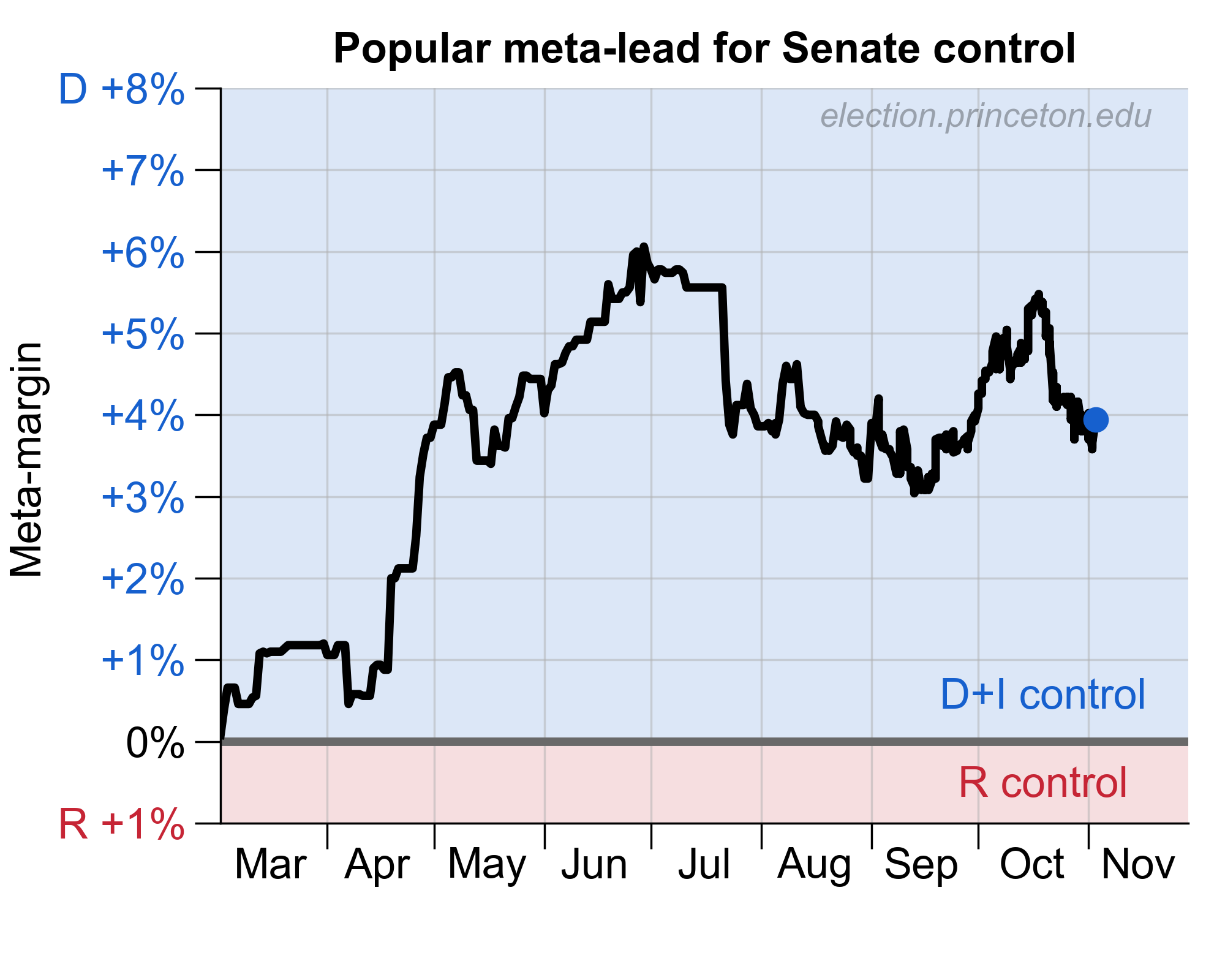Polling conspiracy theories (your response)
I am impressed with the response to my question yesterday. Readers, go see the comment thread. Also, thank you all for the kind words. Yesterd...

Senate: 48 Dem | 52 Rep (range: 47-52)
Control: R+2.9% from toss-up
Generic polling: Tie 0.0%
Control: Tie 0.0%
Harris: 265 EV (239-292, R+0.3% from toss-up)
Moneyball states: President NV PA NC


Click any tracker for analytics and data

Close watchers of politics sense that conditions are turning against Senate Republicans. Exactly when this began has been hard to tell by looking at individual polls. But a statistical aggregate clarifies the answer: the middle of April, at the same time as President Trump’s increasingly wild coronavirus-19 press conferences.
The core calculation is to determine the probability distribution of seat outcomes that results from all 2^22 = 4.2 million possible combinations. The way this is calculated makes it quick and easy to estimate where donations will have the largest impact on Senate control. Use the ActBlue link (for Democrats) in the sidebar, or the WinRed link (Republicans), to give in an optimal way, based on these calculations.
Here’s how the calculation is done.
This graph tracks a snapshot of polls in all Senate races. It covers a 4-week* tracking window and is updated daily. It could be off a bit in either direction, but that offset does not change much over time. Therefore, looking at the direction of change, we can see that conditions have moved toward Democrats, apparently by about 3 seats.
*Full rule: N weeks or 3 polls in 2020, whichever is more data. N=4 through August, N=3 in September, and N=2 from October until the election on November 3. My rating of the race is included as the first poll, which then rotates out as real polls accumulate.
We use head-to-head polls between the likely candidate from each party. Where that candidate is not yet known, we chose the candidate that performs strongest. The median margin is divided by the estimated standard error to get a win probability (a long-tailed t-distribution, which allows for upsets).
The probabilities are all compounded to create a distribution of all possible outcomes. That histogram looks like this:

Note that the histogram is averaged out a little bit by allowing all polls to move up or down together by a few points.
In the time-series graph at the top of this post, the gray shaded zone is a 2-sigma interval (approximately 95% confidence). Today, the median outcome is 53 Democratic/Independent seats.

Finally, all of this is converted to a Meta-Margin. As long-time readers of this site know, the Meta-Margin is defined as how much the poll margins would have to shift in the same direction to make control of the Senate a perfect tossup. For now, we define the Senate as being controlled by Republicans if they win 51 or more seats. (An exact correction, accounting for the fact that the vice-president breaks ties, is coming soon.)
Today, the Meta-Margin is 5 percentage points. It made a pretty large move – 4 points – in the last few months. The change started in the middle of April, at the same time that Donald Trump’s state polls started getting worse for him.
As I wrote above, it is possible using these methods to determine which Senate races will be most pivotal in determining control. Using the voter power measure that I have defined before, “jerseyvotes,” I have calculated the value of turning out (or registering, or flipping) a small number of votes. This gives a measure of how powerful voters are in the state.
| State | Margin | Voter power |
|---|---|---|
| Montana | Bullock +3.5% | 100 |
| Kansas | Bollier +1.0% | 73.5 |
| Maine | Gideon +4.0% | 72.2 |
| Iowa | Greenfield +2.5% | 58.8 |
| Kentucky | Tie | 36.9 |
Assuming that donations pay for activities that move votes, these rankings tell us where donations will have the largest impact on Senate control. Use the ActBlue link (for Democrats) in the sidebar, or the WinRed link (Republicans), to give based on these calculations.
Contributors to this feature: Lucas Manning, Ben Deverett. The code is at https://github.com/Princeton-Election-Consortium/data-backend. Outputs: tables and charts.
I remember one non-partisan poll correctly calling 2016 because its modeling assumed the people that showed up to vote for Obama would pretty much stay home. Our local congress person used the current protests as an opportunity to encourage voting. Let’s hope the current protests don’t prove too cathartic. George Bush said getting voted out of office ‘hurt like hell’. There are going to be plenty of folks that deserve to ‘hurt like hell’ come November. Keep that in mind. 😉
“ActBlue gets too much credit for Democrat fundraising success,” said a senior Republican strategist, pointing to Democrats’ potent small-dollar fundraising apparatus. “Donald Trump is far and away the greatest fundraising tool in the Democrats’ arsenal.”
https://www.cnn.com/2020/07/07/politics/senate-democratic-candidates-fundraising/index.html